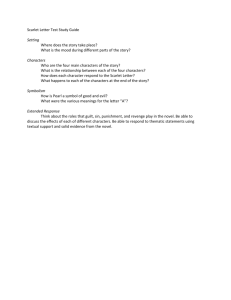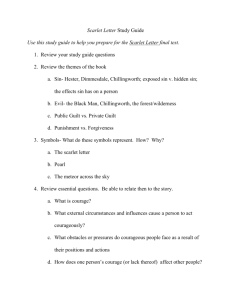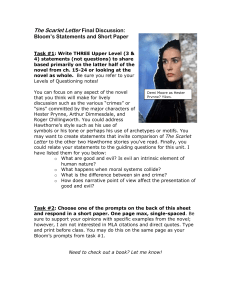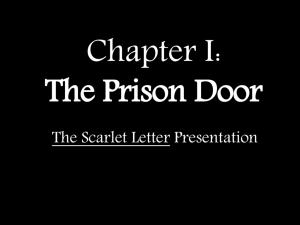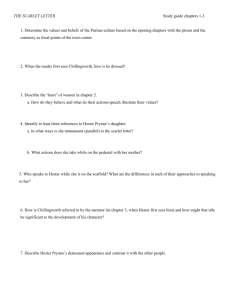The Scarlet Letter
advertisement
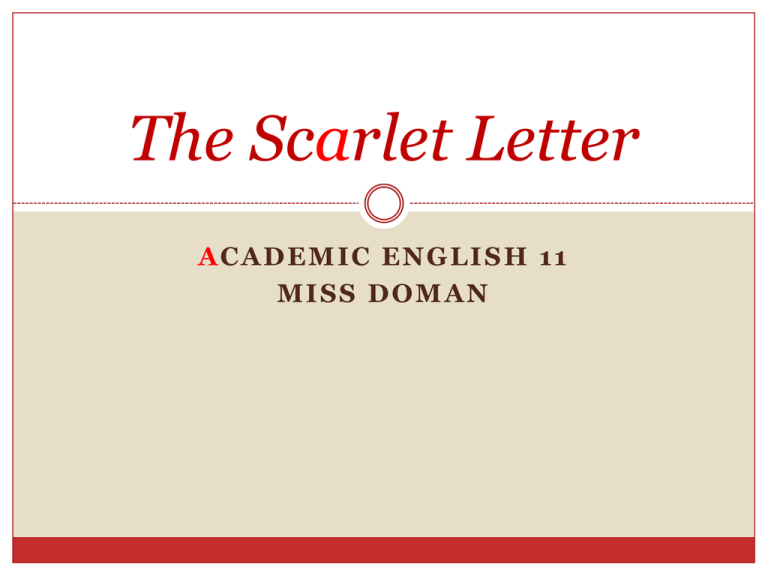
The Scarlet Letter ACADEMIC ENGLISH 11 MISS DOMAN OBJECTIVES To obtain knowledge of Nathaniel Hawthorne’s life and background and how it affected his writing To understand the historical and social context in which The Scarlet Letter was written To identify key literary elements in the novel (setting, characters, mood, climax, symbols, themes) To analyze and discuss events throughout The Scarlet Letter and their implications and meanings ABOUT THE AUTHOR About the Man 1804-1864 Salem, Massachusetts Descended from prominent Puritan family Inherited guilt Solid accomplishment Great guilt Ancestor: William Hathorne Married Sophia Peabody Strength and nobility Reflected in Hester Prynne Nathaniel Hawthorne First Great American “Pro author” First psychological novel Redemption, sin 4,000 copies of The Scarlet Letter sold in the first 10 days Works Novels Short Stories He believed that evil was a dominant force in the world fiction expressed a gloomy version of human affairs “The Scarlet Letter is powerfully written but my writings do not, nor ever will, appeal to the broadest class of sympathies, and therefore will not obtain a very wide popularity.” -Hawthorne, after finishing the novel The ROMANTIC HAWTHORNE • Literary Movement known as Romanticism • concern themselves with the soul, • stress emotions over reason, • and show passions and inner struggles • Hawthorne is haunted by what is obscure, dangerous, and the confines of good and evil, and social relations • All Hawthorne’s work is one form or another of “handling sin” HISTORICAL CONTEXT SUBDIVISION OF ROMANTICISM: GOTHIC LITERATURE, the “dark romantics”(1800-1850) -use of supernatural -motif of double (both good and evil in characters; sin and evil does exist) -depression, dark forests -emphasis on symbolism The Scarlet Letter Published 1850 Set in 17th Century Boston—about 1690 Puritan code of life Main characters Hester Prynne Pearl Prynne Arthur Dimmesdale Roger Chillingworth Spans 7 year period The Scarlet Letter as a SATIRE The Scarlet Letter Plot Love triangle: wife-lover-husband Struggle: good versus evil Characters’ souls at stake Suspense Will identities of lover and husband be revealed? How will identities be revealed? Psychological movement: quest for revenge THEOCRACY word comes from Greek theo = God cratos = rule a theocracy is a government where the civil laws are based (in whole or in part) on religious laws; civil leaders in theocracies are probably also important religious leaders The Scarlet Letter Structure Innovative form Instead of ongoing chronicle of events Series of separate, fully-realized chapters Interspersed with expository chapters Novel begins in media res Action already occurred Characters facing consequences The Scarlet Letter Point of View (POV) Omniscient Author reveals inner and outer characters Asides Social criticism History Psychology All characters in constant state of change Theocracy Act of adultery not important Consequences of adultery more important The “scarlet letter” of the novel’s title refers to a scarlet letter “A” that the novel’s main character is made to wear on her clothing as punishment for her crime of adultery. Major Characters Hester Prynne Novel’s heroine Adulterer First strong female character in American literature Major Characters Pearl Hester’s daughter Illegitimate child Product of adultery Precious to her mother Intelligent, imaginative Major Characters Arthur Dimmesdale Reverend Looked to as leader of community Popular and admired Major Characters Roger Chillingworth Scholar Doctor Sketchy Themes Effects of Sin and Possibility of Redemption Psychological and social consequences of sin Characters’ processes of redemption Applies to: Hester Dimmesdale Chillingworth Secondary Effect: Insight into the Hearts of Others Themes Hypocrisy Conflict between outer appearance and inner reality Depicted in Hester’s relationship with community Illustrated in portrayals of Dimmesdale and Chillingworth Other Noticeable Themes Guilt Revenge Human frailty and Sin Pride Love Vs. hate Fate vs. Free Will Alienation Conflicts Man versus Society Man versus Man Man versus Self Symbols The Scarlet Letter Central symbol of novel Meaning changes as characters change The Scaffold Public exposure of private since Redemption through confession Elements of Nature Good and evil Forest is changeable symbol for both Symbols Irony Dramatic Irony Controls novel Readers know something about a character the other characters do not If characters knew what readers know, plot would be ruined Situational Irony Central to novel’s action Contrast between intention of an action and its result Expectations aroused by situation are reversed Verbal Irony Say one thing and mean another Throughout novel What happens when a private sin becomes a public crime?

